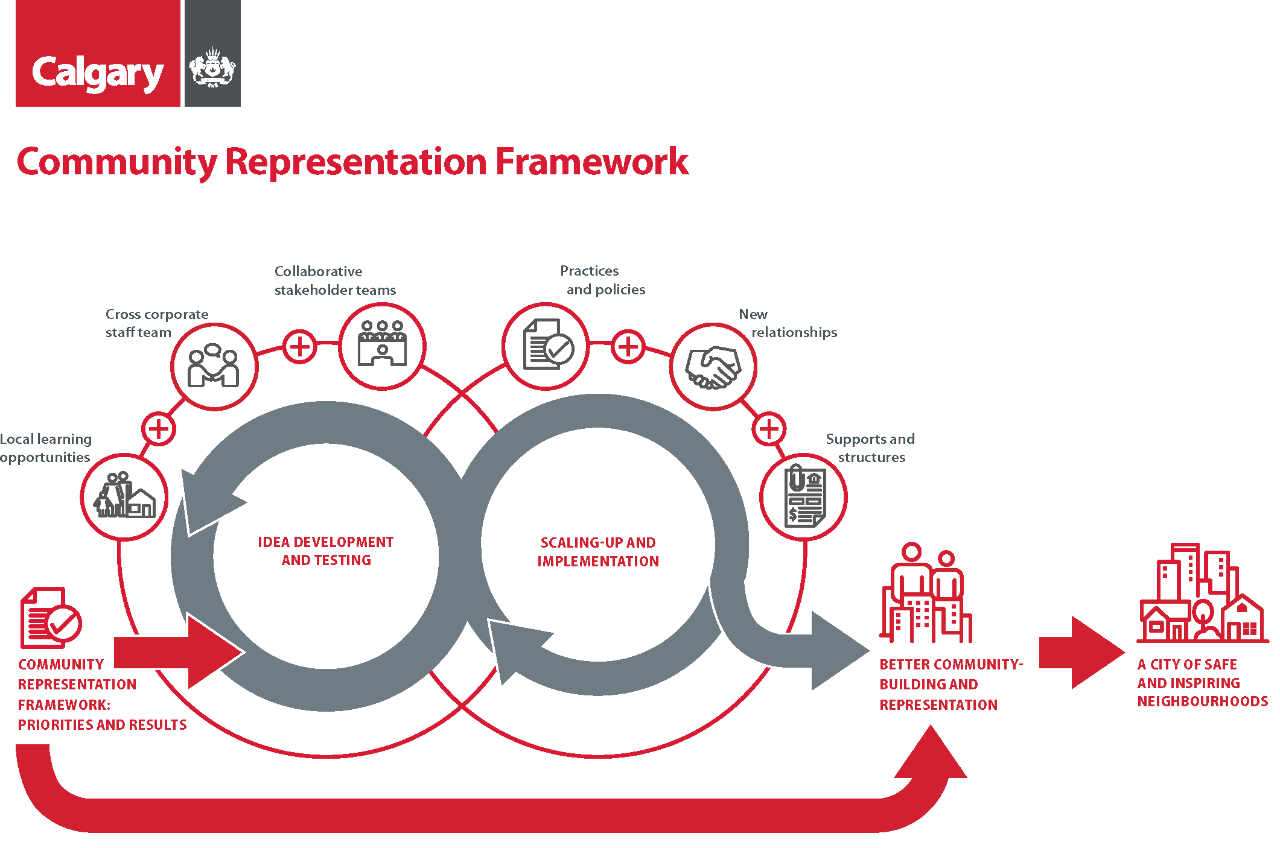Greater Forest Lawn Communications and Governance Model
Council Innovation Funding has been allocated to develop a multi-community model in Greater Forest Lawn, specifically focusing on: piloting a new multi-community governance model; integrating more effective ways of communication; and considering how residents in Greater Forest Lawn communities can better participate in planning and decision making that influence City development projects in their neighbourhoods.
This work follows Council’s Community Representation Framework work, which outlines five priorities and results:
Priority 1: Increase participation and diversity
Increase the number of people and the diversity of participants (across ages, socio-economic, cultural backgrounds and gender identities) involved in collaborative community-building processes and organized community groups. Improving the equity of opportunity for people to participate is an important consideration in achieving this priority.
- Citizens and organized community groups are aware of the opportunities they have to participate in community-building processes.
- Participation in community-building processes is relevant and meaningful to citizens and organized community groups.
- Community-building processes are designed to be welcoming, accessible and provide equitable opportunity for all interested citizens and organized community groups.
- Citizens and organized community groups work collaboratively to foster a shared understanding of the diverse perspectives and interests in their community.
Priority 2: Build trust and respect between stakeholders
Community-building processes should not only result in achieving the priorities of the community and other planning goals. They should also contribute to building and maintaining strong social ties between citizens and groups in the community. This will improve the social cohesion between people in a community and make communities more resilient to change.
- Interactions amongst stakeholders are open, safe and welcoming.
- Citizens, organized community groups, The City and the development and building industry have trusting, respectful relationships.
Priority 3: Raise the capacity of citizens and organized community groups
Develop the skills, knowledge and abilities of individual citizens and members of organized community groups to serve their communities and participate collaboratively in community-building processes. Topic areas should include municipal government (including planning and development) community leadership and organizational governance. By increasing the capacity of these stakeholders and providing a clearer roles and responsibilities, their participation in community-building processes will be more effective.
- Citizens and organized community groups have learning opportunities that help raise their capacity to effectively contribute to community-building processes.
- Collectively, citizens and organized community groups are effective representatives of the diverse perspectives and interests in their community.
- Citizens and organized community groups understand their roles and responsibilities in community-building processes.
Priority 4: Better align the work of The City
Better align the work of The City so assists communities to have the information and subject matter expertise they need to participate in community-building processes, including community-driven initiatives and public realm improvements. Such alignment will help citizens and organized community groups contribute to community-building processes in a more meaningful and relevant way and improve the trust between organized community groups and The City.
- Citizens and organized community groups have timely access to clear, concise information about community-building processes.
- Citizens and organized community groups can effectively navigate services and access subject matter expertise to help them effectively participate in community-building processes.
- Resources are available to support community-driven initiatives and public realm improvements.
- The City’s community-building processes are based on a consistent and predictable approach that can be adjusted for characteristics of community.
- Community-building processes are scalable, so broad public input is sought and used to establish citywide or district goals and local input is sought and used to successfully achieve those goals at the local level.
Priority 5: Support the evolving role and needs of Community Associations
Community associations face new and evolving challenges that can hinder their ability to offer programs and services to local residents and serve as representatives of community interests. To better address these challenges, community associations need new sources of revenue and new collaborative partnerships with other organized community groups so their volunteers have the resources they need to help achieve the goals of their communities.
- Community associations have a strong membership base and adequate volunteer resources.
- Community associations have adequate financial resources to help them achieve their goals.
- Community associations and other organized community groups leverage their resources and knowledge through collaborative partnerships.


